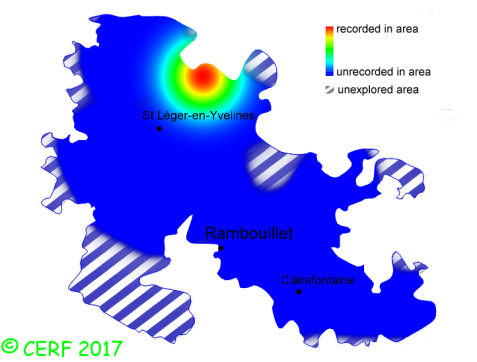|
Cantharellus ferruginascens P.D. Orton
|
common name(s) : Pale Chanterelle
New classification: Basidiomycota/Agaricomycotina/Agaricomycetes/Incertae sedis/Cantharellales/Cantharellaceae
Former classification: Basidiomycota/Homobasidiomycetes/Aphyllophoromycetideae/Cantharellales/Cantharellaceae
synonyms: Cantharellus cibarius-ferruginascens
edibility : edible
|
|
|
The cap is ochre-buff to pale lemon yellow, paler and with greenish shades towards the rim, convex then expanded and depressed; its margin is lobed and irregularly wavy and upturned.
The cap surface is smooth, dry.
The stem is whitish to yellow-ochre, turning yellow strongly when manipulated, tapering towards the base, without ring.
The flesh is whitish to cream-yellow, thin and flabby; its taste is mild; the odour is faint, pleasant;
The gills are ochre-buff, concolorous to cap, darker with age, but these are not gills, but folds or ridges, decurrent, narrow, forked and quite distant, interveined and fusing into one another .
The spore print is pale ochre cream. This species is mycorrhizal.
It grows on the ground, in broad-leaved woods and woodlands, on a rather calcareous soil.
The fruiting period takes place from September to October.
| Dimensions: | width of cap approximately 4 cm (between 2 and 6 cm) |
| | height of stem approximately 3.5 cm (between 2 and 6 cm) |
| | thickness of stem (at largest section) approximately 11 mm (between 5 and 20 mm) |
Distinctive features : Entirely ochre-buff to pale yellow; cap margin often wavy and paler, with olive shades in young specimens; cap and stem turn yellow-rust strongly when manipulated; fertile surface under cap composed of interveined decurrent vein-like ridges, not gills; thin and flabby flesh
Cantharellus ferruginascens is rare and confined in the forest of Rambouillet, and is quite rare, more generally speaking
.
|  | | Above : distribution map of Cantharellus ferruginascens in the forest of Rambouillet |
|
page updated on 14/01/18